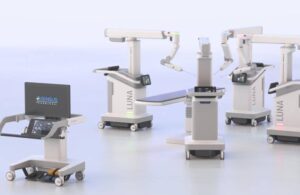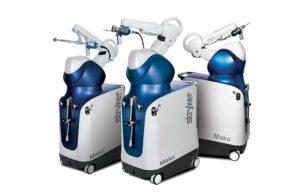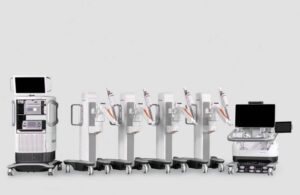
While question marks remain over where medtech is going, the path for surgical robotics remains full of excitement.
Medical technology has experienced a bit of a rocky period lately. Layoffs continue to hamper the space, and financial outlooks are a bit cloudy for some companies.
However, there remains plenty to look forward to in the coming year and beyond. Several companies expect product launches soon, and many big names project significant financial improvements, despite doubts cast by the state of the industry.
One area that always garners a lot of interest surgical robotics.
We’ve previously covered 16 surgical robotics companies you need to know — plus eight more to check out after that. We’ll feature many of those companies below as we look ahead to what’s coming up in surgical robotics. Plenty of positives remain, while some questions linger.
Asensus Surgical’s new Luna platform
In February, Asensus Surgical unveiled its next-generation surgical robot platform, called Luna.
Asensus designed Luna as an integrated digital surgery solution. It features a next-generation surgical platform and instruments, plus real-time intraoperative clinical intelligence. Its final component, a secure cloud platform, applies machine learning to deliver clinical insights. Luna enables Asensus’ vision of performance-guided surgery, President and CEO Anthony Fernando told MassDevice in an interview.
“We already have the Senhance platform, and we’ve learned a lot from that platform,” Fernando said. “[We’ve learned] what surgeons appreciate, what can be improved and where we can actually make a difference. We then looked at all the other players on the market or who are planning to be on the market. Luna kind of addresses all of that.”
Luna features state-of-the-art magnification capability with haptic feedback. Asensus incorporated an “extra step” to make it the best system for the surgeon and the operating room team, Fernando said.
“The true differentiator is the intelligence or the digital capability, the intelligence capability,” he explained. “That will really give a significant advantage to the surgeon and help reduce variability and also reduce fatigue.”
Fernando said the company hopes to get Luna to regulators by the end of 2024 with eyes on getting it to market by mid-2025.
Another big step for Asensus came in March when the FDA granted an expanded pediatric indication for its Senhance robotic surgery system. It’s the first and only digital laparoscopic surgery solution for pediatric patients.
Stryker’s Mako 2.0 and more

Mako Total Knee 2.0 includes a new, intuitive design with customizable workflows. Other key features include a digital tensioner for assessing knee stability intraoperatively during total knee arthroplasty (TKA). It does not require additional instrumentation.
“It takes everything that we’ve learned over those six years and all those procedures and puts them into an advanced application that is way more intuitive, even for the surgeons,” Don Payerle, president of Stryker’s Joint Replacement division, told MassDevice. “If you’ve been a user for many years, it really streamlines your activity. If you’re a new user, it really steps you through what you need to do to perform the total knee once you know what your workflow is. It allows you to customize it so that you can tailor it to exactly how you want it to go.”
Stryker’s big plans for Mako
Stryker CEO Kevin Lobo teased future Mako updates during the company’s fourth-quarter earnings call. In addition to Mako Total Knee 2.0, Stryker plans for two Mako launches next year. It plans to initially launch Mako Spine in the second half of 2024, followed by Mako Shoulder by the end of 2024.
Payerle said Lobo was “the courageous leader who put a stake in the ground” with regard to Mako. According to Payerle, Lobo strove to be a leader in the space. Stryker has pioneered robotics for joint replacement.
“That move was made a number of years ago, and we remain committed to be at the forefront of innovation and market leaders, which we are today,” Payerle said.
He expects the company to continue using Mako as “the anchor for musculoskeletal procedures.” Having established itself in the hips and knees space, Stryker has goals to push even further into broader areas.
“We don’t plan to stop there,” Payerle said. “We want to continue to push the envelope within the markets that we’re in — hips and knees — and provide more value there over time and continue to expand it, particularly for spine and shoulder in the near term. We’re not done.”
Medical Design & Outsourcing: Stryker on steroids: How enabling technology will supercharge surgical robotics
Zimmer Biomet has high hopes for Rosa and ZBEdge

With its Rosa platform and the ZBEdge Dynamic Intelligence platform for hip and knee surgeries, Teplitsky said the company has its enabling technologies under one umbrella.
“We’ve really worked to build it from the ground up,” Teplitsky told MassDevice. “For us, that’s actually a pretty big differentiator. We have the infrastructure across all these platforms, which really makes ZBEdge.
“What we’re trying to do across ZBEdge — whether that’s Rosa or Persona IQ — whatever it happens to be, the goal of ZBEdge is to make anyone that interacts with it smarter, faster, and better.”
She describes Rosa as a multi-application, orthopedic surgical robot platform “designed to work with the surgeons, not for them.” Surgeons can evaluate rows of screens intraoperatively without needing to look outside the field of view.
An even more exciting future?
Teplitsky said the next steps — currently under review at the FDA — include maneuvering the Rosa screens in mixed reality. Surgeons would use voice commands or just eye gaze to control the surgical robot system.
“We’re going to be able to visualize things that we’ve never been able to visualize before,” she said. “It’s looking at basically taking a CT scan that you can then overlay on the current anatomy and understand exactly where you want to go. It’s pretty similar to like a video game. That’s pretty awesome.”
The aim at Zimmer is to bring together a full experience with the integration of its surgical technology with its best-in-class implants. Teplitsky said the company plans to continue to “iterate on what Rosa has to offer and continue to make it smarter, faster, better.”
So our mission at Zimmer Biomet is to alleviate pain and improve the quality of life for people around the world,” she added. “I truly believe that with ZBEdge and what we’re bringing to market with the best-in-class implants, we’re going to change the standard of care in orthopedics.
“This industry is ready, and patients are ready to have improved outcomes and improve their quality of life and reduce their pain. I think we can do it, leveraging technology, so I’m excited. It’s going to be a fun few years here.”
Pushed back timing at Intuitive
The leader in the surgical robotics space generated attention with its fourth-quarter earnings call, but for the wrong reasons. Intuitive Surgical CEO Gary Guthart spooked investors when he said the company does not expect to launch its highly anticipated multiport surgical robotics system in 2023.

“We expect to launch additional [next-generation]-compatible products and operating system software this year,” Guthart said. “Concurrently, we invest in new generations of our multiport platform that bring new and significantly enhanced capabilities.”
Question marks over Medtronic and Johnson & Johnson’s surgical robotics efforts
Two of the biggest names in medtech remain two of the biggest unknowns in the surgical robotics space.

The company announced the first urologic and gynecology procedures with Hugo in Latin America and Asia-Pacific in 2022. The first patient procedure took place in Chile in June 2021. It soon performed the first procedure in Europe in February 2022, following its CE mark. A clinical trial in the U.S. continues.
However, Medtronic has also had some organizational restructuring involving its surgical robotics efforts. In March, Medtronic confirmed the consolidation of its Surgical Robotics and Surgical Innovations operating units. It formed the businesses into a single Surgical operating unit.
Recently, BTIG analysts questioned whether Medtronic has differentiated Hugo enough to displace Intuitive, though they thought Hugo will find a place in certain markets outside the U.S.
“We continue to believe that for many high-volume surgeons, especially within the U.S. and Europe, the switching costs will be too immense initially as ISRG continues to enhance its ecosystem,” said Ryan Zimmerman, Sam Durno and Iseult McMahon at BTIG. “A vast number of surgeons want choice in their robotics system, and while we’re not discounting this, we think MDT’s entrance into the U.S. will be measured.”
Meanwhile, little has been revealed by Johnson & Johnson since it unveiled its Ottava surgical robot in November 2020. Just under one year after the unveiling, the company said it experienced a “temporary setback” with Ottava, resulting in a two-year delay in its development timeline.
More uncertainty arose as layoff notices filed in California in March confirmed that Johnson & Johnson is letting go of nearly 350 employees in the surgical robotics space. The notices list layoffs involving 292 workers at Auris, 47 at Verb Surgical, and four at Ethicon Endo-Surgery. All of the jobs were based in Santa Clara County.
In a statement shared by a spokesperson, the company said: “We continue to be excited about and committed to our Ottava program. We look forward to delivering a competitive soft tissue robotic solution. We expect to provide an update on our progress later this year.”
Others to watch in the surgical robotics space this year
What else should you look out for in surgical robotics? A number of companies recently reported exciting developments for their businesses. Here are a few:
- CMR Surgical
- An exciting company in the space, CMR raised $600 million in a Series D financing round in June 2021. Last November, the company partnered with Johnson & Johnson’s Ethicon to sell its Versius surgical robot in select markets. Versius features freedom of port placement. CMR said this best suits the needs of each patient, allowing surgeons to operate the way they did laparoscopically, but with the benefits of robotic surgery.
- Moon Surgical
- With a couple of regulatory nods in the last several months, Moon Surgical’s robotic platform is set to make its mark soon. The company picked up FDA 510(k) clearance for its Maestro surgical robotics system in December 2022. The Paris- and San Francisco-based company designed Maestro to support surgeons in soft tissue surgical procedures. It then won CE mark approval in April 2023.
- Noah Medical
- In March, Noah received FDA clearance for its Galaxy System for robotic-navigated bronchoscopy. The San Carlos, California-based company designed Galaxy and its accessories to provide bronchoscopic visualization and access. The company is, however, subject to litigation at the moment. A former employee of Johnson & Johnson’s Auris, Dr. Jian Zhang, left in 2015 and founded Noah Medical in 2018. He and Noah Medical are currently subject to litigation from Auris, which alleges the misappropriation of trade secrets. Noah Medical has filed a motion to have the lawsuit dismissed.
- Ronovo Surgical
- The Shanghai-based company closed a new round of financing earlier this year. It brought its total funds raised to more than $50 million since 2020. In doing so, Ronovo exited stealth mode and unveiled its inaugural Carina robotic platform. Carina, a modular system built on proprietary technology, enables configurable robotic assistance for laparoscopic surgeries across multiple specialties.
- Stereotaxis
- St. Louis-based Stereotaxis develops surgical robotics that incorporate magnets for minimally invasive endovascular intervention. The company’s technology can work in conjunction with ablation catheters. It’s also developing a semi-mobile robot platform. The company said last fall that it remains on track for an initial launch next summer.

